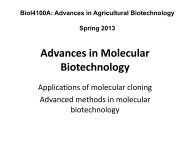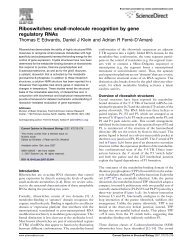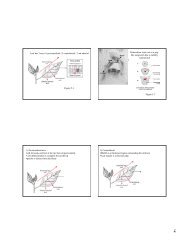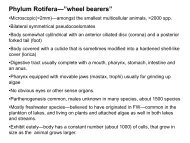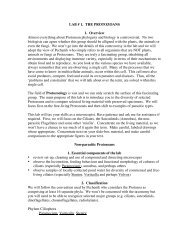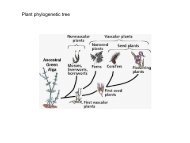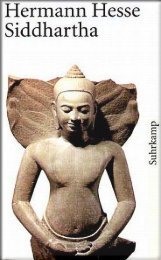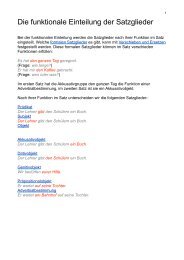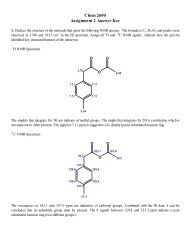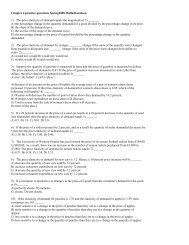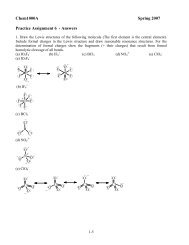Metals and Main-Group Organometallic Chemistry. You
Metals and Main-Group Organometallic Chemistry. You
Metals and Main-Group Organometallic Chemistry. You
You also want an ePaper? Increase the reach of your titles
YUMPU automatically turns print PDFs into web optimized ePapers that Google loves.
CHEMISTRY 3810 Problem Set #5<br />
Topic: <strong>Metals</strong> <strong>and</strong> <strong>Main</strong>-<strong>Group</strong> <strong>Organometallic</strong> <strong>Chemistry</strong>. <strong>You</strong> are responsible for Ch. 9, sections 9.1-9.5; 9.12-9.18 <strong>and</strong> Ch. 15<br />
of Shriver-Atkins<br />
1. Without using reference material, sketch the s-block of the periodic table, including the chemical symbols for the elements,<br />
<strong>and</strong> indicate the trends in (a) melting point, (b) radii for the common cations, (c) the tendency of peroxides to decompose<br />
thermally to simple oxides.<br />
2. Which of the following pairs are most likely to form the desired compound or undergo the process mentioned? Describe the<br />
periodic trend <strong>and</strong> the physical basis for your answer in each case. (a) Cs + or Mg 2+ , form an acetate complex; (b) Be or Sr,<br />
dissolve in liquid ammonia in the absence of air; (c) Li + or K + , form a complex with crypt-[2.2.2].<br />
3. State the trend in the stability of the group oxidation number on descending a group of metallic elements in the p-block.<br />
Illustrate the trend using st<strong>and</strong>ard potentials in acidic solution for <strong>Group</strong>s 13 (Appendices in Shriver-Atkins).<br />
4. The acid-base chemistry of liquid (i.e. anhydrous) ammonia often parallels that of aqueous solutions. Assuming this to be<br />
the case, write balanced chemical equations for the reaction of solid Zn(NH 2) 2 with (a) NH 4 + in liquid ammonia, <strong>and</strong> (b) with<br />
KNH 2 in liquid ammonia.<br />
5. Give balanced chemical equations (or NR for no reaction) for the following cases <strong>and</strong> give a rationale for the reaction or lack<br />
of reaction: (a) Hg 2+ (aq) added to Cd(s); (b) [AlF 6] 3– (aq) with Tl 3+ (aq).<br />
6. (a) Summarize the trends in relative stabilities of the oxidation states of the elements of <strong>Group</strong>s 13 <strong>and</strong> 14, <strong>and</strong> indicate the<br />
elements that display the inert pair effect. (b) With this information in mind, write balanced chemical reactions or NR (for no<br />
reaction) for the following combinations, <strong>and</strong> explain how the answer fits the trends.<br />
(i) Sn 2+ (aq) + PbO 2(s) (excess) → (air excluded)<br />
(ii) Tl + (aq) +Al(s) (excess) → (air excluded)<br />
(iii) In + (aq) → (air excluded)<br />
(iv) Sn 2+ + 0 2(aq) → (air)<br />
(v) Tl + (aq) + 0 2(aq) → (air)<br />
7. Use data from the Appendices in Shriver-Atkins to determine the st<strong>and</strong>ard potential for each of the reactions in Question 6.<br />
In each case, comment on the agreement or disagreement with the qualitative assessment you gave for reactions (i) through<br />
(v).<br />
8. The elements of <strong>Group</strong> 11 generally mimic those of <strong>Group</strong> 1, but there are<br />
important differences due to the much greater electonegativity of the former.<br />
What is this greatly enhanced electronegativity due to? This question<br />
compares the Period 6 elements cesium <strong>and</strong> gold. The enthalpy of electron<br />
attachment of Cs is given in the notes (section 4.2.3) as –45.51 kJ/mol. The<br />
value for Au is a staggering –223 kJ/mol. The first ionization energy of cesium<br />
is 376 kJ/mol. Cesium reacts with gold to form a compound of stoichiometry<br />
CsAu. Recently PDC Dietzel <strong>and</strong> M Jansen reported (Chem. Commun. 2001,<br />
2208) that this compound undergoes ion exchange with tetramethylammonium<br />
ions to form the new compound [Me 4N][Au], which crystallizes in with a<br />
structure identical to that of [Me 4N][Br], <strong>and</strong> highly reminiscent of that of CsCl<br />
(see <strong>Chemistry</strong> 2810 notes.) Rationalize these results.<br />
9. Explain why certain of the following compounds qualify as organometallic<br />
compounds whereas others do not: (a) B(CH 3) 3, (b) B(OCH 3) 3, (c) Na 4(CH 3) 4, (d) SiCl 3(CH 3), (e) N(CH 3) 3, (f) sodium acetate,<br />
(g) Na[B(C 6H 5) 4.<br />
10. Preferably without consulting reference material, construct the periodic table for the s- <strong>and</strong> p-block elements <strong>and</strong> the <strong>Group</strong><br />
12 elements. Head each group with the formula of a representative methyl compound <strong>and</strong> indicate (a) the positions of the<br />
salt-like methyl compounds, (b) the positions of the electron-deficient, electron-precise, <strong>and</strong> electron-rich methyl<br />
compounds, (c) trends in ΔH f° in the p-block.<br />
11. Write formulas for each of the following compounds. For nonionic compounds give alternative names as derivatives of<br />
their hydrogen compounds if they are named as organometallic compounds of the element, <strong>and</strong> vice versa: (a)<br />
trimethylbismuth, (b) tetraphenylsilane, (c) tetraphenylarsonium bromide, (d) potassium tetraphenylborate.<br />
12. Name each of the following compounds <strong>and</strong> classify them: (a) SiH(C 2H 5) 3, (b) BCl(C 6H 5) 2, (c) Al 2Cl 2(C 6H 5) 4, (d) Li 4(C 2H 5) 4, (e)<br />
RbCH 3.<br />
13. Sketch the structures of: (a) methyllithium, (b) trimethylboron, (c) hexamethyldialuminum, (d) tetramethylsilane, (e)<br />
trimethylarsane, <strong>and</strong> (f) tetraphenylarsonium.<br />
14. Describe the tendency toward association through methyl bridges for the trimethyl compounds of boron, aluminum,<br />
gallium, <strong>and</strong> indium. Give a plausible exp lanation for the difference between boron <strong>and</strong> aluminum.<br />
15. For each of the following compounds, indicate those that may serve as (1) a good carbanion nucleophile reagent, (2) a mild<br />
Lewis acid, (3) a mild Lewis base at the central atom, (4) a strong reducing agent. (A compound may have more than one of<br />
these properties.) (a) Li 4(CH 3) 4, (b) Zn(CH 3) 2, (C) (CH 3)MgBr, (d) B(CH 3) 3, (e) A1 2(CH 3) 6, (f) Si(CH 3) 4, (g) As(CH 3) 3.
CHEMISTRY 3810 Problem Set #5<br />
16. For an appropriate compound from problem 15, give balanced chemical equations for: (a) the reactions of one of the<br />
carbanion reagents with AsCl 3 <strong>and</strong> SiPh 2Cl 2, (b) the reaction of a Lewis acid with NH 3, (c) the reaction of a Lewis base with<br />
the Lewis acid [HgCH 3][BF 4.<br />
17. Give examples of the synthesis of organometallic compounds by each of the following reaction types <strong>and</strong> describe the<br />
factors that favor reaction in each case: (a) reaction of a metal with an organic halide, (b) transmetallation, (e) double<br />
replacement.<br />
18. Determine which compound in each pair is likely to be the stronger reducing agent <strong>and</strong> explain the physical basis for your<br />
answer: (a) Na[C 10H 8] <strong>and</strong> Na[C 14H 10], (b) Na 2[C 10H 8] <strong>and</strong> Na 2[C 14H 10] (where C 10H 8 is naphthalene <strong>and</strong> C 14H 10 is<br />
anthracene).<br />
19. Determine the likely reaction type, write a reasonable balanced chemical equation (or NR for no reaction), <strong>and</strong> explain the<br />
systematics of the reaction type that led you to decide whether or not a reaction is likely.<br />
(a) Calcium with dimethylmercury.<br />
(b) Mercury with diethylzinc.<br />
(c) Methyllithium with triphenylchlorosilane in ether.<br />
(d) Tetramethylsilane with zinc chloride in ether.<br />
(e) Trimethylsilane with. ethene in a solution of chloroplatinic acid in 2-propanol.<br />
20. Give balanced chemical equations that illustrate: (a) direct synthesis Of SiCl 2(CH 3) 2; (b) redistribution. of SiCl 2(CH 3) 2.<br />
21. Using silicon <strong>and</strong> a chloromethane as the primary starting materials, give equations <strong>and</strong> conditions for the synthesis of a<br />
poly(dimethylsiloxane).<br />
22. Disregarding compounds with metal-metal bonds, describe the trends in the oxidation states for the organometallic<br />
compounds of <strong>Group</strong>s 13 through 15.<br />
23. For the simple organometallic compounds, briefly describe the periodic trends in (a) metal-carbon bond enthalpies, (b)<br />
Lewis acidity, (c) Lewis basicity for <strong>Group</strong>s 1, 2, 12, 13, <strong>and</strong> 14.<br />
24. Summarize the trend in each process listed below, giving your reasoning:<br />
(a) The relative ease of pyrolysis of Si(CH 3) 4 <strong>and</strong> Pb(CH 3) 4 at 300ºC.<br />
(b) The relative Lewis acidity of Li 4(CH 3) 4, B(CH 3) 3, Si(CH 3) 4, <strong>and</strong> Si(CH 3)Cl 3.<br />
(c) The relative Lewis basicity of Si(CH 3) 4 <strong>and</strong> As(CH 3) 3.<br />
(d) The tendency of Li 4(CH 3) 4 <strong>and</strong> Hg(CH 3) 2 to displace halide from GeCl 4.<br />
25. Taking into account sensitivity to oxygen <strong>and</strong> moisture <strong>and</strong> the volatility of the compound, indicate the general techniques<br />
(vacuum line, inert atmosphere, Schlenk ware, or open flasks) that are most appropriate for h<strong>and</strong>ling the following<br />
organometallic compounds: (a) solution of Li 4(CH 3) 4 in ether, (b) trimethylboron, (c) triisobutylaluminum, (d) AsPh 3 (solid),<br />
(e) (CH 3) 3SiOSi(CH 3) 3 (liquid).<br />
26. The 'saturated' cyclic compound Si 6(CH 3) 12, which has a near-UV absorption b<strong>and</strong>, can be reduced by sodium to produce a<br />
cyclic radical anion [Si 6(CH 3) 12] – . What types of molecular orbitals are thought to be involved in these processes? Model<br />
this process by making the hydride analog [Si 6H 12] in HyperChem, using the Model Builder followed by a PM3 geometry<br />
optimization of the neutral molecule. Then change the charge to –1, <strong>and</strong> multiplicity to 2, perform a single point calculation,<br />
<strong>and</strong> plot the SOMO. What kind of orbital is this? Why does reduction of Si 6(CH 3) 12 not lead to cleaving of the Si–Si bond<br />
in this molecule (Hint: consider the Si–Si bond order in the anion.)<br />
27. Give equations <strong>and</strong> conditions for the synthesis of R 2Si=SiR 2 from R 2SiCl 2 <strong>and</strong> indicate the type of R group that is<br />
necessary to yield a stable product (list specific structures of some suitable groups.)<br />
28 The bulk price per mole of trimethylaluminum is an order of magnitude greater than that of triethylaluminum. Describe the<br />
methods of synthesis available for these two compounds <strong>and</strong> rationalize the price difference.<br />
29 Correct any errors <strong>and</strong> explain the nature of the errors in the following statements. (a) The methyl compounds of lithium,<br />
zinc, <strong>and</strong> germanium are associated through multi-center M-C-M bonds because they each contain fewer methyl groups<br />
than valence orbitals on the metal. (b) Substitution reactions of organometallic compounds of silicon such as<br />
chloroethylmethylphenylsilane generally occur by an associative mechanism with complete loss of stereochemistry. (c)<br />
The tendency toward radical reaction by ER 4 compounds increases on going down the group from E = Si to Pb, which<br />
correlates with decreasing E–C bond enthalpies.<br />
30 The compound (C 6H 5) 3Pb–Pb(C 6H 5) 3 survives up to about 300°C. Write plausible reactions for this compound with (a)<br />
sodium in liquid ammonia, (b) HBr, <strong>and</strong> (c) [Pt(PPh 3) 4] (this compound readily loses up to two triphenylphosphine lig<strong>and</strong>s).<br />
Give your reasoning in each case.<br />
31 Based on general trends in atomic energy levels, explain the probable order of the π-π* separation in R 2Si=SiR 2 <strong>and</strong><br />
R 2G=GeR 2. Give specific examples of how this energy order might be reflected in the reactions of digermene in comparison<br />
with disilaethenes.<br />
32 Use the AM1 method in HyperChem to calculate the MO diagram for the model disilaethene H 2Si=SiH 2. Now convert this<br />
into the trans-pyramidalized form by breaking the Si-Si bond, rotating each fragment about 40° in opposite directions, <strong>and</strong><br />
re-forming the bond. This structure should be saved <strong>and</strong> single-point calculations peformed; it will not likely stay in the<br />
bent form on minimization. Compare the energies <strong>and</strong> shapes of the frontier orbitals (in this case the two highest filled <strong>and</strong>
CHEMISTRY 3810 Problem Set #5<br />
two lowest empty MO’s). Rationalize the observation of significant trans-pyramidalization in many solid-state structures<br />
of disilaethene compounds.<br />
33 The synthesis of the first stable germaethene was reported by C. Couret, J. Escudie, J. Satge, <strong>and</strong> M. Lazraq, J. Am. Chem.<br />
Soc. 109, 4411 (1987). Summarize the reactions involved in this synthesis <strong>and</strong> speculate on why each reaction is favorable.<br />
Describe the interaction of Lewis bases with this germaethene <strong>and</strong> propose reasons for the interaction of the germaethene<br />
with a Lewis base <strong>and</strong> lack of similar interaction for a simple alkene. (Copy appended to the end of this problem set.)<br />
34 Given Ge(CH 3) 3Cl, H 2C=CH(C 6H 5), <strong>and</strong> other reagents of your choice, <strong>and</strong> drawing on analogies with the chemical<br />
properties of silicon, give balanced chemical equations <strong>and</strong> conditions for the synthesis of (CH 3) 3GeCH 2CH 2(C 6H 5).<br />
35 Provide equations for two different synthetic routes to compounds possessing a stable Si=Si double bond.<br />
36 Discuss the criteria used in deciding whether a pp-pp double bond exists in E=E compounds (E a group 14 or 15 element).<br />
37 When an E=E compound is bent towards transpyramidalization: (a) which MO is most stabilized? Why?; (b) which MO is<br />
most destabilized? Why?<br />
38 Starting with (a) an organic halide of your choice, (b) elemental arsenic (c) elemental chlorine, <strong>and</strong> (d) other st<strong>and</strong>ard<br />
reagents <strong>and</strong> solvents, describe with equations a synthetic route to a symmetrical compound with a stable As=As bond.<br />
39 Predict the product(s) of the reaction of Mes 2Si=SiMes 2 with (a) bromine; (b) phenol; (c) sulfur; (d) (PPh 3) 2Pt (Hint: see<br />
structure #15 on p. 277).<br />
40 Write out arrow-pushing step-by-step reaction paths which rationalize the production of the following products from a<br />
symmetrical diphosphene: # 3; #7; #8; #13 <strong>and</strong> 14; #12 (as listed on page 84 of the lecture notes).
CHEMISTRY 3810 Problem Set #5
CHEMISTRY 3810 Problem Set #5




